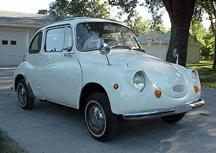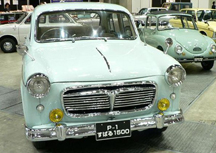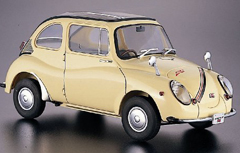The 1950's Subaru
In 1953, five Japanese companies merge to form Fuji Heavy Industries Ltd, with a "Subaru" cluster of stars as its official logo. Better known by the Greek name Pleiades, part of the Taurus constellation, Subaru is also Japanese for 'unite'.
The P-1, named the Subaru 1500 the following year, used the first Japanese-manufactured monocoque body. This passenger car provided excellent riding comfort and driving stability with its front-wheel independent suspension with a coil spring and double-action oil damper combination, and rear-wheel rigid axle suspension with a three-leaf spring and double-action oil damper combination.
The first U.S. Subaru is the 360. This is a very small rear wheel drive which had a 2-stroke, 25 horsepower 356 cc engine (thus the 360 name), it weighed under 1000 pounds, got 66.3 mpg, went 0-50 in over 37 seconds, and cost around $1,297. It came in a few different models, the 2 door sedan, and the "Young S" 2 dr. sedan, minivan, a truck version, and even a mini race car as well. There may have been as many as 6000 of these imported through the later part of the 1950's. The main features that were present with the 360 included achieving a lighter body, easier production, sufficient interior space to accommodate four adults, excellent ride comfort, and developing a lightweight and high-power, high-durability engine. In addition to the monocoque body used to achieve a lighter weight, the head of each and every rivet was filed down to save weight - technology that had previously been used in aircraft was used extensively throughout the prototype.
In 1958, a passenger car with a distinctive individuality was released: the Subaru 360 minicar was unveiled. At the time, Japanese automobile manufacturers were working on developing small "people's cars" as advocated by the Japanese government. With its roots in aircraft manufacturing, Subaru took up the challenge of building a small, affordable car that could perform well, and the four-passenger, four-wheel Subaru 360 minicar became a milestone in the history of Japan's automobile industry. Dubbed the Ladybird due to its distinct shape, the Subaru 360 enjoyed tremendous popularity for more than a decade before finally ceasing production in May 1970.




